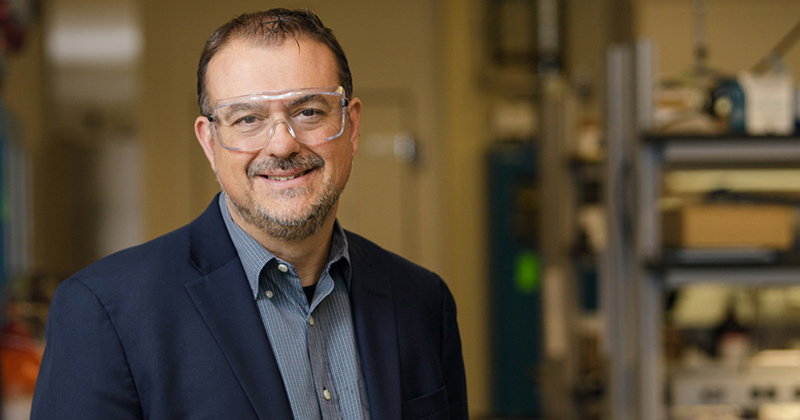


Upcycling plastics
Photo by Evan Krape July 05, 2023
UD researchers describe a new method for recycling plastics that contain common yet hazardous chemicals
Plastic pollution is a significant global challenge that has major environmental, economic and health-related consequences. Nearly 400 million tons of plastic waste are produced every year, and microplastics are now ubiquitous in habitats worldwide, according to a United Nations report. To address these challenges, researchers are finding new ways to reduce plastic production, creating more sustainable materials, and are developing new and better ways to recycle existing plastics and polymers.
Now, a new paper in Nature Sustainability describes a method for upcycling plastics that contain chlorine, which had previously been difficult to remove from plastic waste in a way that is safe and effective. This new two-step procedure can be conducted at low temperatures while preventing toxic emissions, with the potential to improve recycling methods for polymers that contain these common chemical additives.
This study was conducted by researchers at the University of Delaware and was supported by the Center for Plastics Innovation (CPI). The research was led by Pavel Kots, a CPI post-doctoral researcher working in the lab of Dionisios Vlachos, the Unidel Dan Rich Chair in Energy and Professor of Chemical and Biomolecular Engineering and the corresponding author of this paper.

While currently studied upcycling technologies do well at converting certain types of plastic wastes (namely polyolefins) into materials like lubricants, waxes, and fuels, these catalysts are not well-equipped to deal with chlorine. This is a major challenge because polymers like polyvinyl chloride (more commonly known as PVC, often found in plumbing materials) are some of the most used synthetic polymers, with more than 40 million tons produced every year. In addition, the byproduct of PVC decomposition is hydrochloric acid, which is highly corrosive and toxic.
“Mixed plastics and food packaging wrapping material contain chlorine that poisons catalysts, and developing processes that can treat real-world materials is essential,” Vlachos said about the significance of this work.
This study builds off previous work in the Vlachos Research Group on upcycling plastic wastes to lubricant oils, said Kots, where the researchers were able to convert “clean” plastics (ones not contaminated with chlorine, PVC or other compounds) with high product yields. “Real-world waste is inherently more complex, so we started to work with PVC-contaminated mixtures,” explained Kots. “And because of how notoriously toxic it is, we thought that if we could deal with PVC, we could handle almost anything.”
In the process of finding a chemical reaction that could safely convert chlorine-containing plastic into lubricants, the researchers conducted solid-state nuclear magnetic resonance spectroscopy (NMR) in order to understand the chlorine removal process at a molecular level, working in partnership with Caitlin Quinn, NMR spectroscopist and core advisor at the NMR laboratory housed in the College of Arts and Sciences’ Department of Chemistry and Biochemistry.
The method described in this paper is a two-step, low-temperature reaction that involves an adsorptive dichlorination step followed by a hydrogenolysis step. Using magnesium-aluminum mixed oxide (Mg3AlO4.5), the researchers were able to trap chlorine in an inert form when it’s bound to magnesium as MgCl2. Along with efficiently trapping chlorine and keeping it from being emitted in a toxic or corrosive form, this also means that there are no sorting, cleaning or impurity extraction steps required.
“It was challenging to make the two pieces of our strategy work together and produce high yields of lubricants — it is not a simple on/off reaction,” Kots said. “It turns out that the chlorine trapping should match the catalytic upcycling step, so taking into account the high reactivity of hydrogen chloride and PVC, and the complex nature of plastic, it took us substantial time to get reliable results.”
One advantage of this approach is that it works at much lower temperatures than previous methods, which means that less energy is needed to break down PVCs and other plastics wastes. And while their current system still has relatively long reaction times, the researchers will evaluate if these reaction times could be reduced. This approach can also be used to remove other types of halogens from plastics, so materials like fire retardants could be treated using similar methods in the future.
Overall, this study connects fundamental research on plastic conversion with practical considerations for working with complex waste streams, the researchers said. “It is very important to show that hydroconversion is a feasible strategy to produce lubricants from waste, even when dealing with contaminated feedstocks, because that is a viable, mild, and energy-saving pathway to deal with plastic waste,” said Kots. “Now, by getting high yields out of PVC-contaminated feedstock, we show that with necessary treatment and chlorine trapping, hydroconversion can be versatile.”
Added Vlachos, “This opens the door to handling mixed plastic waste from landfill or waste cans, something impossible until now.”
The complete list of co-authors includes Pavel Kots, Brandon C. Vance, Caitlin Quinn, Cong Wang, and Dionisios Vlachos.
This research was supported by the Center for Plastics Innovation (CPI), an Energy Frontier Research Center funded by the US Department of Energy, Office of Science, Office of Basic Energy Sciences, award number DE-SC0021166. This research used instruments in UD’s Advanced Materials Characterization Lab (AMCL) at the University of Delaware; measurements were made possible by the Delaware COBRE program, which is supported by the National Institutes of Health (grant 5 P30 GM110758-02).
Contact Us
Have a UDaily story idea?
Contact us at ocm@udel.edu
Members of the press
Contact us at 302-831-NEWS or visit the Media Relations website

